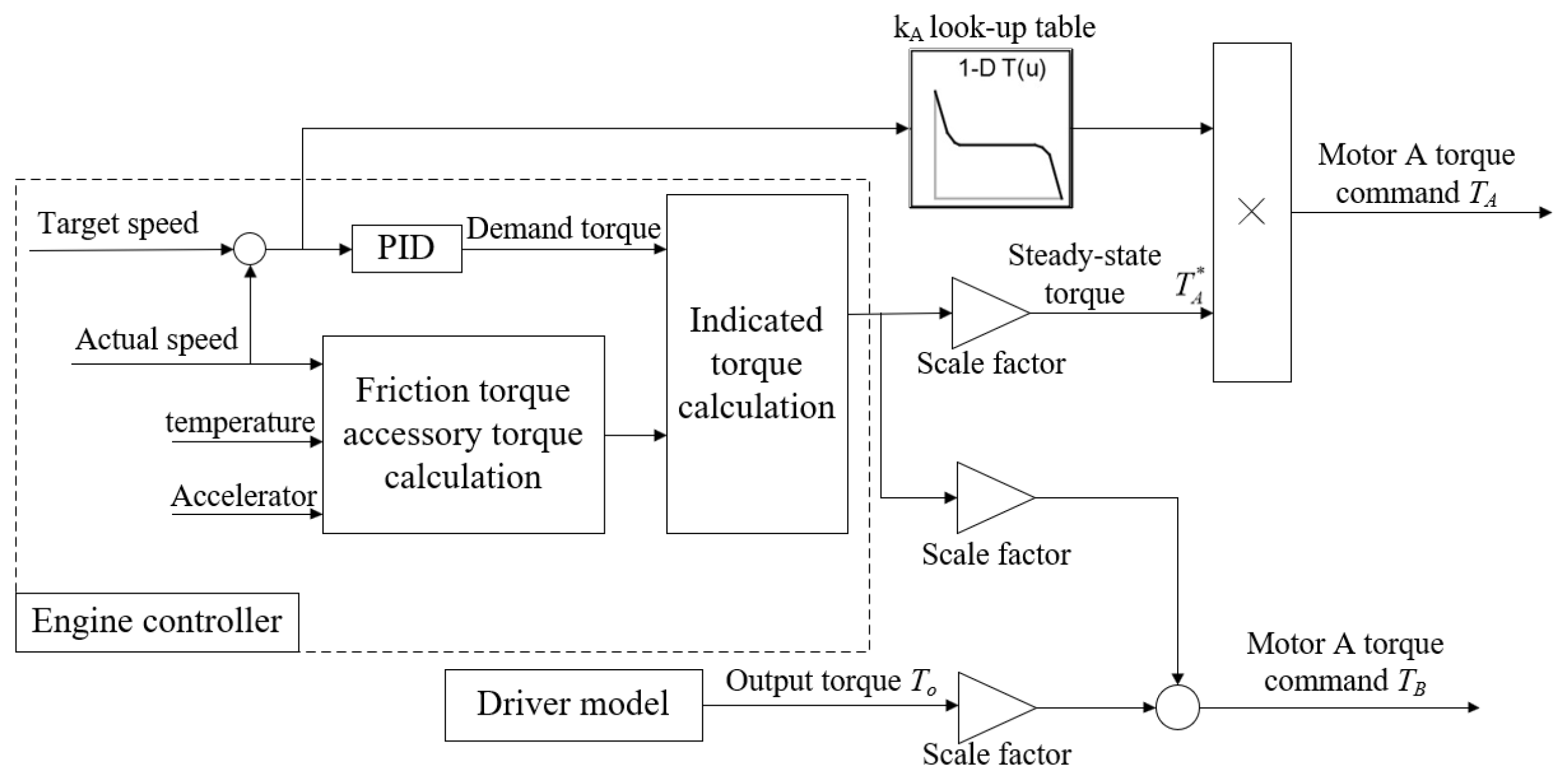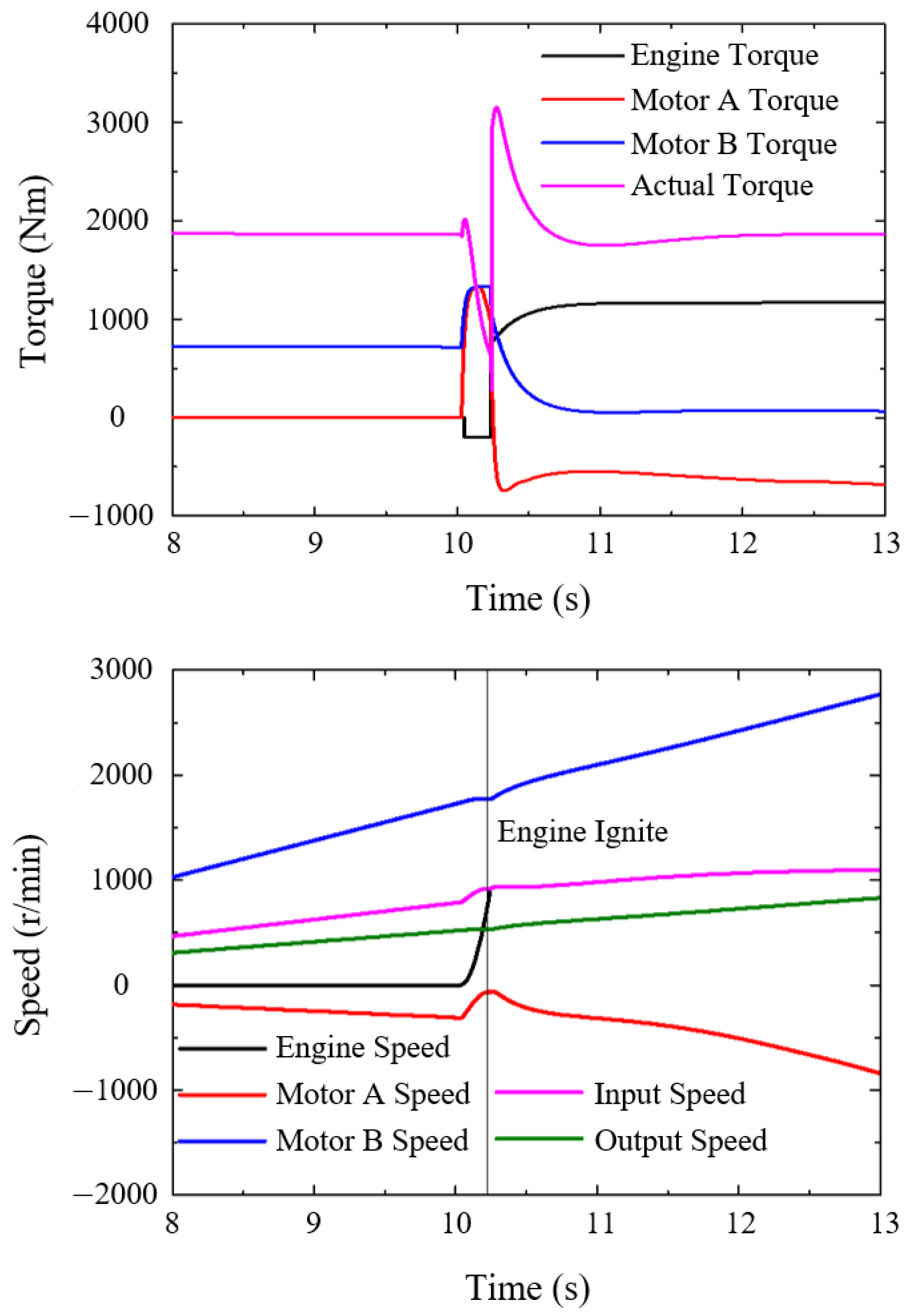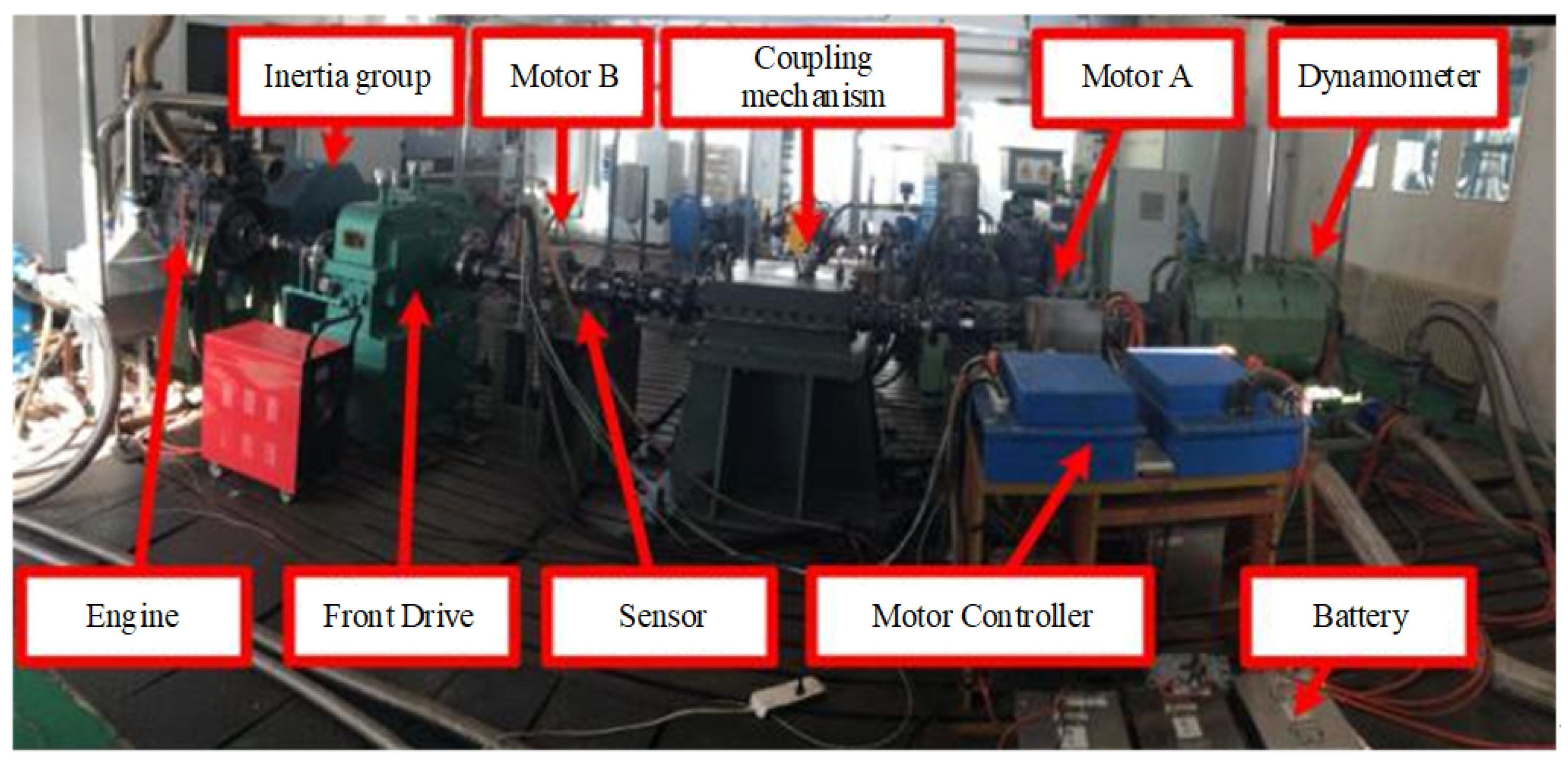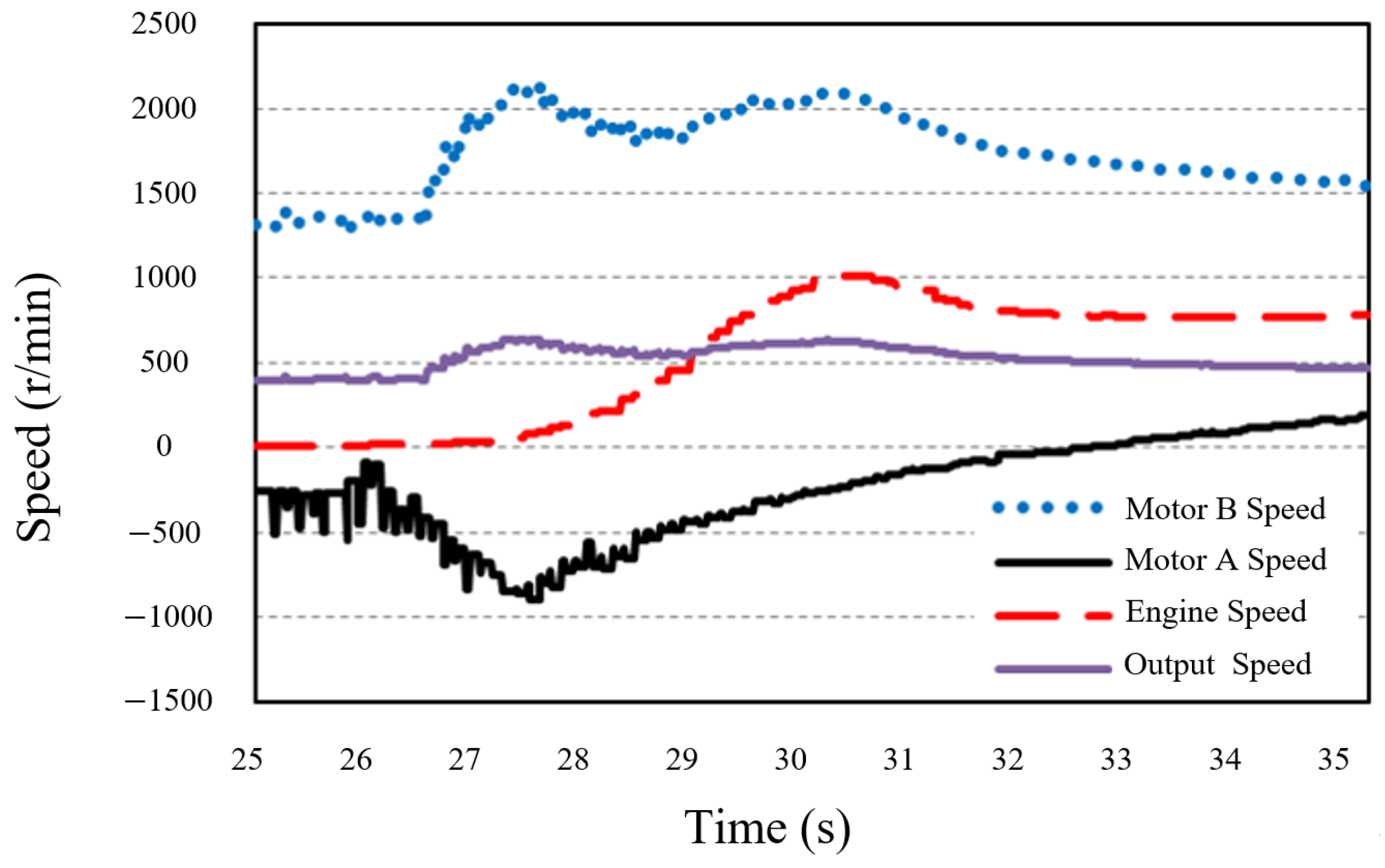The Coordinated Control Strategy of Engine Starting Process in Power Split Hybrid Electric Vehicle Based on Load Observation
Abstract
:1. Introduction
2. Power Split Hybrid System Scheme
3. Hybrid System Modeling
3.1. Engine Model
3.2. Motor Model
3.3. Coupling Mechanism
4. Engine Start-Up Coordination Control Strategy
4.1. Clutch Speed Regulation Phase
4.2. Clutch Engagement Phase
4.3. Anti-Drag Phase of the Engine
4.4. Engine Active Speed Regulation Stage
5. Ground Load Observer
6. Control Strategy Simulation Verification
7. Bench Test
8. Conclusions
Author Contributions
Funding
Data Availability Statement
Conflicts of Interest
References
- Zhao, Z. Mode Transition Control for Four Wheel Drive Hybrid Electric Car. J. Mech. Eng. 2011, 47, 100. [Google Scholar]
- Ni, C.; Zhang, Y.; Zhao, Q.; Boukehili, A. Dynamic Torque Control Strategy of Engine Clutch in Hybrid Electric Vehicle. J. Mech. Eng. 2013, 49, 114–121. [Google Scholar]
- Li, L.; Li, X.; Lu, H.; Deng, J. A study on the motor cranking strategy and start performance of a HEV engine. Automot. Eng. 2016, 38, 133–140. [Google Scholar]
- Zhang, N.; Zhao, F.; Luo, Y. A Dynamic Coordinated Control Strategy for Mode-Switch of Hybrid Electric Vehicle Based on the Effect Control. In Proceedings of the FISITA World Automotive Congress; Springer: Berlin/Heidelberg, Germany, 2013. [Google Scholar]
- Luo, Y.; Wang, Z. Mode Switching Coordination Control of Electromechanical Continuously Variable Transmission Hybrid Drive System. Automot. Eng. 2015, 5, 526–532. [Google Scholar]
- Yonggang, L.; Datong, Q.; Zhenjun, L.; Yang, Y. Research on Engine Starting Control Strategy for Single-motor Heavy Hybrid Power System during Running. Automot. Eng. 2015, 37, 49–54. [Google Scholar]
- Yan, X.; Zhong, Y.; Zhong, Z. Research on Optimal Control of Power Smoothing Switching in HEV Transmission System. Automot. Eng. 2008, 30, 309–311. [Google Scholar]
- Qin, D.; Shang, Y.; Yang, G. Smoothness control of start-up engine during pure electric traveling of plug-in hybrid vehicle. J. Chongqing Univ. 2015, 4, 1–9. [Google Scholar]
- Zhu, F.; Chen, L.; Yin, C.; Shu, J. Dynamic modelling and systematic control during the mode transition for a multi-mode hybrid electric vehicle. Proc. Inst. Mech. Eng. Part D J. Automob. Eng. 2013, 227, 1007–1023. [Google Scholar]
- Kim, H.; Kim, J.; Lee, H. Mode Transition Control Using Disturbance Compensation for a Parallel Hybrid Electric Vehicle. Proc. Inst. Mech. Eng. Part D J. Automob. Eng. 2011, 225, 150–166. [Google Scholar]
- Kim, S.; Park, J.; Hong, J.; Lee, M.; Sim, H. Transient Control Strategy of Hybrid Electric Vehicle during Mode Change. In Proceedings of the SAE 2009 World Congress; SAE: Warrendale, PA, USA, 2009. [Google Scholar]
- Canova, M.; Guezennec, Y.; Yurkovich, S. On the Control of Engine Start/Stop Dynamics in a Hybrid Electric Vehicle. J. Dyn. Syst. Meas. Control 2009, 131, 636–650. [Google Scholar]
- Li, J.; Wei, H. Coordinated Control of Downshift Powertrain of Combined Clutch Transmissions for Electric Vehicles. Math. Probl. Eng. 2014, 2014, 643762. [Google Scholar]
- Cui, T.; Yan, Y. Harmonized Switching Control of Parallel Hybrid Electric Vehicle from Pure Electric Motor to Engine Driven. J. Highw. Transp. Res. Dev. 2014, 31, 153–158. [Google Scholar]
- Zhao, Z.; Hu, X.; Jiang, J. Sliding Mode Variable Structure Coordinated Control and Real-time Optimization for Starting Dual Clutch Transmission. J. Mech. Eng. 2012, 48, 87–105. [Google Scholar]
- Liu, B. Modern Control Theory, 2nd ed.; Mechanical Industry Press: South Norwalk, CT, USA, 2006. [Google Scholar]













| Name | Value |
|---|---|
| Vehicle mass | 40,000 kg |
| Maximum engine power | 1103 kW |
| Maximum engine speed | 4200 r/min |
| Battery capacity | 60 Ah |
| Battery charging and discharging power | 180 kW |
| Maximum motor power | 370 kW |
| Maximum motor speed | 6000 r/min |
| Driving Mode | Main Clutch CL0 | Clutch CL1 | Brake B1 |
|---|---|---|---|
| Pure electric drive | separate | separate | engage |
| Pure mechanical drive | engage | engage | engage |
| EVT1 | engage | separate | engage |
| EVT2 | engage | engage | separate |
Disclaimer/Publisher’s Note: The statements, opinions and data contained in all publications are solely those of the individual author(s) and contributor(s) and not of MDPI and/or the editor(s). MDPI and/or the editor(s) disclaim responsibility for any injury to people or property resulting from any ideas, methods, instructions or products referred to in the content. |
© 2024 by the authors. Licensee MDPI, Basel, Switzerland. This article is an open access article distributed under the terms and conditions of the Creative Commons Attribution (CC BY) license (https://creativecommons.org/licenses/by/4.0/).
Share and Cite
Han, L.; Zhou, X.; Yang, N. The Coordinated Control Strategy of Engine Starting Process in Power Split Hybrid Electric Vehicle Based on Load Observation. Electronics 2024, 13, 3373. https://doi.org/10.3390/electronics13173373
Han L, Zhou X, Yang N. The Coordinated Control Strategy of Engine Starting Process in Power Split Hybrid Electric Vehicle Based on Load Observation. Electronics. 2024; 13(17):3373. https://doi.org/10.3390/electronics13173373
Chicago/Turabian StyleHan, Lijin, Xuan Zhou, and Ningkang Yang. 2024. "The Coordinated Control Strategy of Engine Starting Process in Power Split Hybrid Electric Vehicle Based on Load Observation" Electronics 13, no. 17: 3373. https://doi.org/10.3390/electronics13173373





